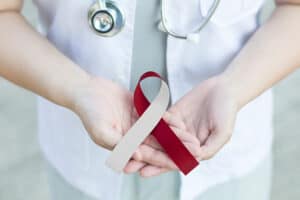Important Facts about Oral Cancer
April is Oral Cancer Awareness Month, and as such, we’d like to share with you some important facts about oral cancer and its detection, prevention, and treatment. Oral cancer is a serious disease, with roughly 54,000 new diagnoses in the United States each year. Oral cancer affects people from all walks of life across this country, and by increasing public understanding of oral cancer, we hope to better fight the diseases. Let’s dive into some important facts about oral cancer:
First, let’s talk about the causes of oral cancers. There are a variety of cancers that fall under the collective heading “oral cancer”, and like most cancers, they’re not fully understood yet. However, medical research has established links between oral cancer and some of its causes:
- Tobacco and alcohol use: Let’s be clear: any form of tobacco use, including smoking or chewing tobacco, drastically increases your risk for oral cancers. Excess alcohol consumption has been shown to do the same thing. Partaking of both has a compounding effect, which further increases the odds of contracting oral cancers.
- HPV. The sexually transmitted human papillomavirus (specifically the HPV 16 type) has been linked to some oral cancers.
- Age. As with most cancers, the risk of oral cancer increases with age. People over 40 are the most likely to develop oral cancers.
- Sun Exposure. Cancer of the lip can be caused by excess sun exposure.
The good news is that many of these causes of oral cancer can be avoided. By eliminating or restricting tobacco and alcohol, engaging in safer sex practices, and limiting sun exposure you can go a long way to reducing your odds of contracting oral cancer.
So when should you worry about oral cancer? There are a number of signs and symptoms that may indicate the presence of oral cancer, and knowing them is a good step. If you notice any of the following symptoms, please contact your health care provider and arrange for an oral cancer screening:
- A sore, irritation, lump, or thick patch in your mouth, lip, or throat
- A white or red patch in your mouth
- A sore throat or a feeling that something is caught in your throat
- Difficulty chewing, swallowing or speaking
- Difficulty moving your jaw or tongue
- Swelling of your jaw that causes dentures to fit poorly or become uncomfortable
- Numbness in your tongue or other areas of your mouth
- Ear pain
While these symptoms do not necessarily guarantee the presence of oral cancer, they are cause for concern. Get them checked out as soon as possible.
Oral cancer screenings are the best way to detect oral cancer and know what the next course of action might be. As part of Oral Cancer Awareness Month, there are screening events going on around the country. By following this link, you can check and see if there’s one near you. Alternately, either your doctor or your dentist can perform a screening. Indeed, looking for signs of oral cancer is part of what your dentist does during a routine exam. It’s a fairly simple process, involving both visual and tactile inspections of your mouth, lips, gums, face, and neck. If necessary, your health care provider may decide that x-rays or other images are in order and have those taken as well.
So what happens if the worst comes to pass and a health care provider detects the presence of oral cancer? It’s difficult to say in the abstract, as the course of treatment will depend on the extent of the cancer and how early it has been detected. Surgery to remove the cancer or chemotherapy and radiation to inhibit its growth are all options. Your doctor will discuss the best course of action with you and guide you through it.
Oral cancer is something we should all be aware of at any stage of life. Hopefully, you now have a better understanding of what oral cancer is, what causes it, and how to prevent and detect it. Please share this article with your friends and family over the rest of Oral Cancer Awareness Month and do your part to increase awareness of and education about this disease.
